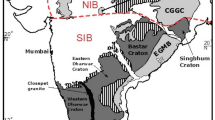Abstract
Volcan Pico de Orizaba, which marks the eastern end of the Trans-Mexican Volcanic Belt, is one of the largest andesitic composite volcanoes in America. It is located above a series of crustal distensive faults making the boundary of the Coast Plains of the Gulf of Mexico from theAltiplano. For this reason, the volcano shows an asymmetry: from the west, its elevation is about 3,000 m whereas on the eastern side it reaches 4,000 to 4,500 m from its base.
The Pico de Orizaba is composed of a primitive stratovolcano raised by a recent summit cone. It has been built by three very distinct volcanic and magmatic phases.
-
1.
The first one, probably discontinuous effusive activity, lasted more than one million years. It is mainly composed of two pyroxenes-andesites with scarce associated basaltic and dacitic lava-flows. Amphibole is an accessory mineral in most differentiated lavas. On the eastern flank, numerous massive and autobrecciated lava-flows pass outward into thick conglomeratic formations. This effusive phase has built a primitive central volcano and a parasitic cone: the Sierra Negra.
-
2.
The second phase is of short duration — about 100,000 years or less — in comparison with the first period. It seems that this period began with the formation of a caldera followed by the extrusion of amphibole dacite domes and the overflow of viscous silica-rich (andesite to dacite) lava flows on the northern flank. An intense explosive activity develops:pelean nuées ardentes are associated with extrusion of the domes; numerous plinian eruptions leading to widespread dacitic pumiceous air-falls are produced by both the central and the adventive volcanoes. This sequence of events is interpreted as the progressive emptying of a superficial chamber containing differenciated magma. A rhyolite flow erupted during this phase.
-
3.
The age of the recent phase is better defined. It started 13,000 years B.P. with the eruption of a dacitic ash-flow containing pumice and scoria-bombs. This was such an intense event that products were found 30 km S.E. of the summit, erasing the top of the former volcano and creating a large crater (4–5 km wide). The present cone, of 1,400–1,500 m elevation, grew in this crater. During a period of 7,000 to 8,000 years, the new stratovolcano experienced various important pyroclastic eruptions with a cycle of the order of 1,000 to 1,500 years. The pyroclastic flows (ash, pumice, and bombs) associated with air-fall deposits are of Saint-Vincent type. They present an heterogeneous dacitic and andesitic magma. The dacitic component is similar to previous differenciated materials. On the other hand, the andesitic magma appears somewhat similar to lava-flows from morphologically young cones erupted outside the central vent system. This eruptive cycle can be interpreted as the result of reoccurring injections of deep basic magma within the crustal chamber. For the last 5,000 years the activity of the modern Pico de Orizaba has again been essentially effusive (andesites) with periodic plinian eruptions.
Similar content being viewed by others
Bibliographie
Anderson, T.H., Flett, J.S., 1903,Report on the Eruption of the Soufrière in Saint-Vincent, 1902, and on a Visit to Montagne Pelée in Martinique. Phil. Trans. R. Soc. Lond., sér. A,22, p. 353–553.
Bardintzeff, J.M., Boudon, G., 1979,Nuées ardentes de l’éruption d’Avril–Mai 1979 de la Soufrière de Saint-Vincent (Antilles). C.R. Acad. Sc. Paris,289, sér. D, p. 891–894.
Bloomfield, K., Valastro, S., 1977,Late Quaternary Tephrochronology of Nevado de Toluca Volcano, Central Mexico. Inst. of Geol. Sc. Research Council. Overseas Geol. and Min. Res.,46, 15 p.
Cantagrel, J.M., Robin, C., 1979,K-Ar Dating on Eastern Mexican Volcanic Rocks — Relations between the Andesitic and the Alkaline Provinces. J. of Volc. and Geoth. Res.,5, p. 99–114.
—————, —————, 1981,Les grandes étapes d’évolution d’un volcan andésitique composite: exemple du Nevado de Toluca (Mexique). Bull. Volcanol.,44, p. 177–188.
Demant, A., 1981,L’Axe neó-volcanique transmexicain. Etude volcanologique et pétrographique. Signification géodynamique. Thèse Doct. Etat Univ. Aix-Marseille, 259 pp. + annexes.
Lhur, J.F., Carmichael, I.S.E., 1980,The Colima Volcanic Complex, Mexico. I. Post-Caldera Andesites from Volcan Colima. Contr. Mineral. Petrol.,71, p. 343–372.
Mooser, F., Meyer-Abich, H., McBirney, A.R., 1958,Catalogue of Active Volcanoes of the World: Part VI, Central America. Napoli, Intern. Ass. Volcanol., 146 pp.
Nixon, G.T., 1981,The Petrology of Volcan Iztaccihuatl, Central Mexico. Unpubl. PhD Thesis, Univ. British Columbia, Vancouver.
Robin, C., 1976,Présence simultanée de magmatismes de significations tectoniques opposées dans l’Est du Mexique. Bull. Soc. Géol. Fr., (7),XVIII, n. 6, p. 1637–45.
-----, 1981,Relations Volcanologie-Magmatologie-Géodynamique: application au passage entre volcanismes alcalin et andésitique dans le Sud Mexicain (Axe transmexicain et province alcaline orientale). Thèse Doctorat d’Etat Univ. Clermont-Ferrand II. Publ. Annales Sc. Univ. de Clermont 1982, n. 70, Fasc. 31, 503 pp.
-----,Cantagrel, J.M., Vincent, P.M., (sous presse),Activité pyroclastique récente (< 15000 ans) au Pico de Orizaba et au Popocateptl, Mexique: Nuées ardentes retombantes (type Saint-Vincent). Bull. PIRPSEV, n. 62, CNRS-INAG, Paris, 36 pp.
-----,Tournon, J., 19 ,Spatial Relations of Andesitic and Alkaline Provinces in Mexico and Central America. Can. J. Earth Sc.,15, p. 1633–41.
Roobol, M.J., Smith, A.L., 1976,Mount Pelée, Martinique. A Pattern of Alternating Eruptive Styles. Geology,4, p. 521–524.
Shepard, J.B., Aspinall, W.P., Rowley, K.C., Pereira, J., Sigurdsson, H., Fiske, R.S., Tomblin, J.F., 1979,The Eruption of Soufrière Volcano, Saint-Vincent, April–June 1979. Nature,282, p. 24–28.
Thorpe, R.S., Francis, P.W., 1975,Volcan Ceboruco — a Major Composite Volcano of the Mexican Volcanic Belt. Bull. Volcanol.,39, p. 201–213.
—————, 1977,Andesitic Pyroclastic Flows from Colima Volcano. Nature,265, p. 724–725.
Author information
Authors and Affiliations
Rights and permissions
About this article
Cite this article
Robin, C., Cantagrel, J.M. Le Pico de Orizaba (Mexique): Structure et evolution d’un grand volcan andesitique complexe. Bull Volcanol 45, 299–315 (1982). https://doi.org/10.1007/BF02597254
Received:
Revised:
Accepted:
Issue Date:
DOI: https://doi.org/10.1007/BF02597254




